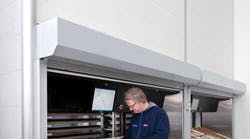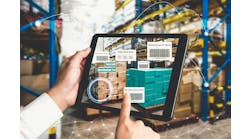E-commerce and custom manufacturing in lots of one are driving the need to pick and handle individual pieces (sometimes called “eaches” or “split-case handling.”) Vertical lift modules (VLMs), along with horizontal and vertical carousels, are being built around each picking.
The very recent advancements in controls and inventory management software to drive the VLMs are allowing new markets, applications and industries to rely on them.
Historically, VLMs were considered primarily storage devices for applications such as MRO (maintenance repair operations), samples, tool, die and fixture storage. Key benefits were optimized floor space, security, ergonomic picking and inventory visibility. These needs and applications hold true today, but with the advent of picking “one inventory” of parts for manufacturing operations, ecommerce, retail and wholesale, the reality of a VLM order picking system was born.
Facilities looking to consolidate departments or facilities and their inventories into one area led to VLMs becoming batch pick order fulfillment systems. VLM order picking systems are organized using three models depending on SKU count, velocity and required speed and labor requirements. The three models are:
➤ Pick & pass,
➤ Pick & consolidate and
➤ Universal work station.
In each model the VLMs are configured with integrated software and often intelligent conveyor.
For pick & pass operations the VLMs work in tandem and allow operators to pick and intelligently pass open orders to each required VLM work station for completion.
For pick & consolidate every operator picks from a pod (or work station) of two or more VLMs. The operators are batch picking multiple orders simultaneously and send their completed portion of an order to a central consolidation area where they are married, packed and shipped.
The universal work station integrates one or more VLMs with a few horizontal carousels and a limited number of flow rack lanes into one integrated pod or work station. This allows one operator to pick from a blend or “best-of-breed” of technologies simultaneously. This minimizes work flow and touches—which reduces labor. The exact blend of equipment is based on the items which make up the order’s physical size, velocity, quantity and replenishment needs.
Regardless of the methodology or application, the recent increase in the VLM’s speed, capacity and reliability play a large part in its success as being both a high density storage device and an order picking system.
A vertical lift module’s four core benefits are ergonomics, space savings, flexibility and cost effectiveness. Over the past year and looking into the future there are new features and trends which will improve on these core benefits to meet an organization’s needs.
First, the basics. A VLM is a series of trays in a column in both the front and back with an inserter/extractor device running in the center. With a push of a button, scan of a barcode or click of a mouse, a tray is extracted or placed back in storage in the smallest space possible.
Ergonomics
Reducing and eliminating reaching, stretching and bending has never been more important, considering America’s graying workforce. With the average age of today’s working baby boomer pushing 46 this becomes even more relevant. Likewise, the diversification and the alarming increase in obesity in the American work force make it important for organizations to create a work environment where everyone can work safely and quickly.
VLMs deliver the trays to the operator through a pick window. The physical height at which the tray is delivered can be personalized by each individual operator. Six-foot-plus men and five-foot women don’t have to compromise; they can simply designate their own comfort level.
One of the newest ergonomic features is tilt tray delivery. Trays are delivered to the pick window and then tilted to allow operators to access the rear of the tray. This tilting action reduces reaching, stretching and bending. The manager can select specific trays to tilt or every tray. By incorporating partitions and dividers, containers and totes parts stay in their proper location, ready for the next pick.
Space Savings
By focusing on more capacity, eliminating wasted space between stored items and maximizing otherwise wasted space to the ceiling, a VLM can help organizations free up 85% or more of their current floor space.
The trend is to increase tray capacity and widths. By providing more capacity per tray, storage cost per square foot can be reduced and multiple picks on each tray can increase productivity. Just a few years ago, VLMs were available in 98” widths. Today’s VLM tray spans up to 157” wide. This extra capacity helps reduce the number of required units and cost of ownership while accelerating return on investment.
Space between the items is being optimized down to fractions of an inch. The VLMs use a light array in the rear of the pick window to scan the height of the items on a tray every time a tray is used. Once a tray’s height requirement is known, the VLM’s controls dynamically find a storage location within the unit to store the tray, virtually eliminating wasted space. Organizations can elect to allow every tray to be stored to maximize space or to select specific trays and keep them either closest to the pick window for faster retrieval times or towards the top of the unit for less-used items.
Flexibility
VLMs are usually constructed modularly, allowing units to be shorter or higher, and moved as needed.
Item heights on trays are detected and stored automatically. Multiple weight capacity trays can be mixed within one VLM unit to improve storage capacity while reducing the number of units required. Likewise, pick windows can often be raised, lowered, added or subtracted based on future needs.
Increased weight capacities and “super sized” tray widths are designed to use fewer units. Integrated pick-to-light systems, including a transaction information center light strip or laser pointers that put a red dot on the exact locations to pick, are designed to increase picker speed and accuracy.
Inventory management software can be integrated not only to the VLM, but to most organizations’ WMS or ERP systems for total inventory visibility. This new generation of software ranges from a simple parts look-up database on the controls screen to a full-fledged WCS (warehouse control system) package.
The key is to optimize space, throughput and labor. Space is managed in three dimensions on the VLM and carousels. Proper machine logic increases throughput by maximizing VLM movement.
Most important is the ability to vary the labor required for a time period based on needed throughput. Managers can add more operators per units to meet peak demand or multiple work stations and VLMs can be operated with less labor during slow periods.
Cost Effectiveness
VLMs are fast to implement in existing facilities and work areas and their modularity accommodates future growth and change.
A few of the key factors to calculate for an ROI include the value of the floor space saved (often 85% or greater), reduced direct labor (up to 2/3 less), reduced injury and litigation costs due to poor ergonomic conditions and value of the space and labor you would need to increase existing product lines or production.
Ed Romaine is chief marketing officer at Sapient Automation (www.GetSapient.com) and vice chair for the Automated Storage & Retrieval Systems (AS/RS) group of Material Handling Industry of America (MHIA).



